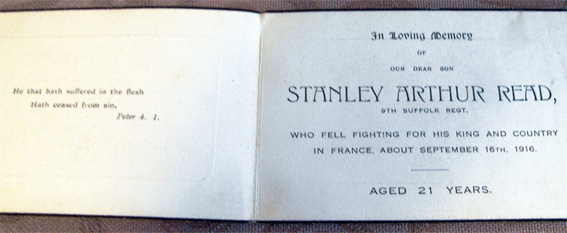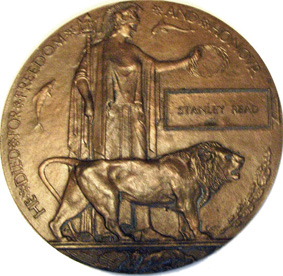Stanley was born in Melton in 1895. By 1911, he was working as a butcher’s boy but at the time he enlisted, in September 1914, he was working as a gardener at Foxborough Hall, Melton, for Mr Percy Crossman.
Upon enlistment, he joined the 9th Suffolk Regiment who were raised in Shoreham in September 1914. When Stanley joined the battalion, they were under canvas but, owing to the poor weather, they were sent to billets in Brighton.
In March 1915, they returned to Shoreham and their training began in earnest. Mock attacks were often held at Cissbury Ring, an Iron Age hill fort near Worthing now under National Trust protection. In April, the battalion moved to Reigate and in mid-June to Blackdown Barracks on Pirbright Camp.
It was not until the end of August 1915 that the battalion received notification they were to proceed to France; the 9th Suffolks sailed from Southampton on 30th August, arriving in Boulogne at midnight the following morning. They went directly to Allette for training in preparation for the front line. On 21st September, orders came sending the battalion on as seventy-mile march to Bethune over four rain-drenched nights. They had been promised forty-eight hours rest upon arrival. This was not to be and, at 04:00, the battalion and Stanley received orders that they were to proceed to Vermelles to take part in the Battle of Loos. It was during this battle that the 9th Suffolks sustained one hundred and thirty-five casualties and Sergeant Arthur Saunders became the first member of the Suffolk Regiment to be awarded the Victoria Cross. On the 1st July 1916, the 9th Suffolks were fighting in the Ypres Salient based at Sailly Labourse. One month later and the battalion was ordered to the Somme, arriving in the Albert Sector on 4th August and taking over trenches at Mailly-Maillet Wood, where they remained for the next three weeks.
Their next task was a particularly distressing one: to clear the battlefield of the dead from Ulster Division.
In early September 1916, the battalion went south to the Somme area and, on the 11th, they were in trenches near Combles. It was here, on 13th September, the battalion was ordered to advance and take the high ground between Morval and Les Boeufs. In front of them lay a heavily-defended, German redoubt known as the “Quadrilateral”. It had withstood several previous attempts to capture it causing significant casualties within the ranks of the attacking forces. The battalion war diary for the 13th September describes the day:
“Battalion ordered to attack enemy’s trenches. “B”, “C” and “D” Companies attacked at 06:20 am. First two lines of enemy’s trenches were captured, but owing to heavy casualties from artillery and machine gun fire the situation could not be cleared up. At 7:30 pm “A” Company were ordered to attack the Quadrilateral but failed to reach their objective owing to very heavy machine gun fire. A new trench was dug by the battalion which enabled them to get in touch with the 2nd Sherwoods on the left and the 8th Bedfords on the right. It also cleared up the situation. During these attacks the battalion behaved splendidly and it is regretted that the casualties were heavy.”
The casualties were as follows. Officers: two killed and ten wounded. Other Ranks: Fifteen killed and one hundred and eighty-five wounded. Stanley Arthur Read was one of the men killed in the attack. His body was not recovered and he is remembered on the Thiepval Memorial and Melton War Memorial. For his war service, Stanley’s family received his 1914-15 Star and British War and Victory Medals.

Memorial Card for Stanley Read

